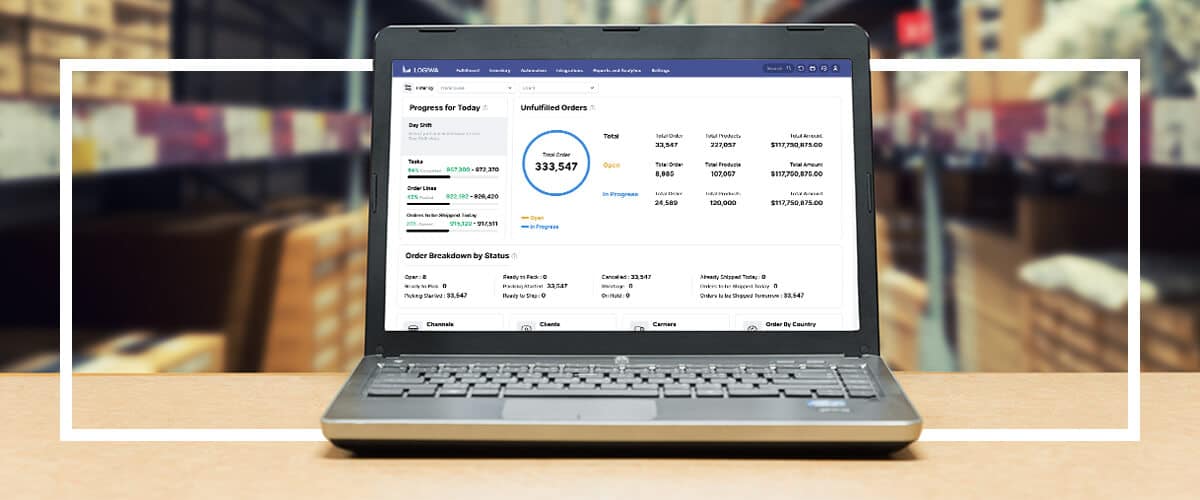Enter headless architecture for warehouse management platforms. This design separates backend database applications from frontend design elements, enabling the flexibility and scalability needed for effective warehouse management solutions.
In this article, we examine the rise of headless architecture for warehouse and fulfillment management platforms, explain why this structure is so effective, and make some predictions about where this technology is going in the near future.
Contents
- What is headless architecture in warehouse management software?
- The rise of headless architecture in warehouse management
- Benefits of headless platforms in warehousing
- Future trends in headless warehouse management systems
- Successfully navigate the future of high-volume fulfillment management with Logiwa’s headless architecture
- FAQs about headless architecture in warehouse software
What is headless architecture in warehouse management software?
A headless warehousing application decouples the backend, which holds all inventory, order, tracking, and customer data, from the front end, which holds all employee- and customer-facing input systems and design elements. In practice, this means that changes can be made to either component in isolation without affecting the operation of the other component. So, for example, if changing business needs demand a switch to a different database management system, this can be implemented on the backend without at all affecting the look and feel of the warehouse management system for employees who interact with it every day.
All headless architectures contain a frontend, backend, and an API, or interface, for communications between the frontend and backend systems. The backend typically consists of a database management system, such as MongoDB or Azure SQL, which stores all warehouse data and takes queries from the front end to retrieve that data. Some common frontend components in warehouse management platforms include:
- Warehouse management: Display inventory details including volumes, temperature requirements, fragility, and zone locations
- Inventory management: Display order details including grouped waves, single- and multi-item orders, shipment tracking, and order fulfillment progress
Analytics modules: Display statistics and data on relevant KPIs, such as inventory turnover, task completion times, and job volumes
Logiwa IO’s Pioneering Architecture video demonstrates the flexibility of headless architecture.
The rise of headless architecture in warehouse management
Legacy software systems have no sharp distinction between frontend presentation components and backend database components. Any major change to backend storage components have an impact on the user interface and vice versa. This crippled the ability to make an isolated change without causing ripple effects everywhere else.
As the technology advanced, many software systems migrated into virtual, cloud-based environments for greater security and ease of access. The increased connectivity enabled by this transition caused a proliferation of businesses producing software products to augment other online software products. Many of these were “microservices,” or small components specializing in one particular piece of the puzzle that integrated with other services.
To stay afloat in the microservice environment, established players had to break down traditional monolithic systems into smaller components that could communicate with, or be replaced by, microservices. The headless architecture was a result of the breakdown of monolithic systems into smaller parts.
Logiwa recognized this trend in the broader software industry and realized the need for headless architecture, within warehousing. Logiwa IO is the next evolution—a fulfillment management system that takes advantage of headless architecture as well as AI-driven optimization, an industry leading app store, and an intuitive UI/UX.
Benefits of headless platforms in warehousing
Following are a few of the benefits that headless architecture brings to warehousing software:
- Flexibility: Separating the backend and front end makes warehousing platforms more flexible, as changes can be made to one end in isolation from the other. This invites greater configuration of individual components, since it is easier and safer to make changes in a more flexible headless environment.
- Scalability: With greater flexibility comes greater scalability. Increasing order volume and frequency might necessitate making a major change to the backend architecture to accommodate higher traffic loads, for example. In a headless architecture, such a change can be made without affecting the interface used by employees and customers.
- Integration: Specialized components more easily hook up with the right external systems and platforms, including ecommerce platforms, shipping, accounting, and robotics systems. With separate front- and backends, external systems only interact with exactly the components they need to.
- Security: Separated components reduce the severity of security incidents, since deliberate or even accidental damage done to one component won’t cross-contaminate the entire system.
- Distributed development and testing: Headless systems can be developed by independent teams working in parallel, which results in faster deployment, updating, and maintenance. Testing is also easier with headless architectures because system components can be tested in isolation. This makes causes of failure more transparent and speeds up debugging.
- Enhanced performance: All of the previous benefits lead to a better and faster-performing warehouse and fulfillment management system. This is vital for modern businesses that need real-time data for processes like analytics and stock level optimization.
- Cost-effectiveness: Greater flexibility and scalability means fewer slow and costly system-wide overhauls. Headless architecture also decreases development and maintenance costs through easier integrations and distributed development and testing. All of this means cost savings and higher ROIs.
Future trends in headless warehouse management systems
Industry experts expect the following trends in the area of warehouse software to continue for the foreseeable future:
- Real-time data: Fast and accurate real-time data on inventory and order details will only continue to grow in importance for optimizing fulfillment times and volumes, stock levels, and demand forecasting in an ever-changing marketplace. Quality data will be of paramount importance for getting the most out of growing AI technologies in this space.
- AI and automating warehouse workflows: The deluge of data collected by modern warehousing systems will be harnessed by AI systems to optimize all manner of operational processes, including labor management, picking and packing processes, and strategic decision-making. The automation of routine processes will continue, reducing error rates and freeing up human workers for more engaging tasks.
- Strategic approaches: Businesses that take a more strategic approach to adopting headless warehouse management systems will be best positioned to reap all of these benefits. Choosing the right platform that not only integrates seamlessly with existing systems but is also adapted to navigate challenges for the future of fulfillment is a key strategic choice.
Successfully navigate the future of high-volume fulfillment management with Logiwa’s headless architecture
Headless architecture, which separates frontend interface components from backend database components, is gaining prominence in warehousing due to their greater flexibility and scalability than traditional architectures. Headless platforms are more secure, cost-effective, better-performing, and more easily integrated with external systems.
With an increasing need for flexible solutions that deliver fast and accurate real-time data in an age of AI and automation, businesses that adopt the right headless warehousing platform will have an important edge.
Schedule a call with one of Logiwa’s fulfillment experts to see what the future of warehousing and fulfillment technologies can do for your operations.





